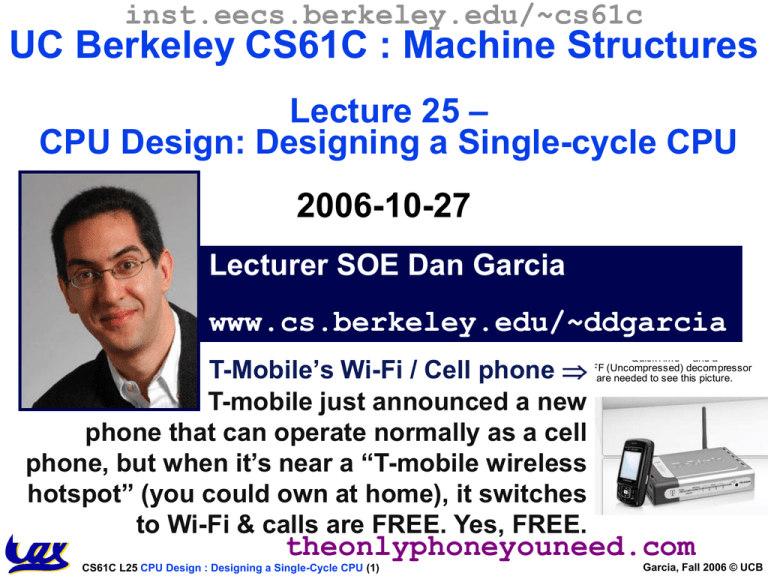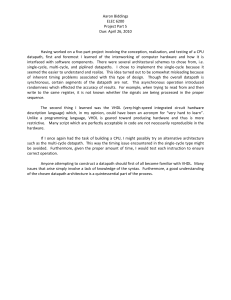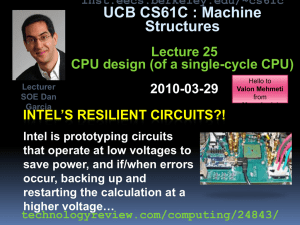2006Fa61C-L25-ddg-1c..
advertisement

inst.eecs.berkeley.edu/~cs61c
UC Berkeley CS61C : Machine Structures
Lecture 25 –
CPU Design: Designing a Single-cycle CPU
2006-10-27
Lecturer SOE Dan Garcia
www.cs.berkeley.edu/~ddgarcia
QuickTime™ and a
TIFF (Uncompressed) decompressor
are needed to see this picture.
T-Mobile’s Wi-Fi / Cell phone
T-mobile just announced a new
phone that can operate normally as a cell
phone, but when it’s near a “T-mobile wireless
hotspot” (you could own at home), it switches
to Wi-Fi & calls are FREE. Yes, FREE.
theonlyphoneyouneed.com
CS61C L25 CPU Design : Designing a Single-Cycle CPU (1)
Garcia, Fall 2006 © UCB
Five Components of a Computer
Computer
Processor Memory
(passive)
Control
(where
programs,
data live
Datapath when
running)
CS61C L25 CPU Design : Designing a Single-Cycle CPU (2)
Devices
Input
Output
Keyboard,
Mouse
Disk
(where
programs,
data live
when not
running)
Display,
Printer
Garcia, Fall 2006 © UCB
Datapath Summary
• The datapath based on data transfers
required to perform instructions
+4
ALU
Data
memory
rd
rs
rt
registers
PC
instruction
memory
• A controller causes the right transfers
to happen
imm
opcode, funct
Controller
CS61C L25 CPU Design : Designing a Single-Cycle CPU (3)
Garcia, Fall 2006 © UCB
CPU clocking
For each instruction, how do we control the
flow of information though the datapath?
• Single Cycle CPU: All stages of an
instruction are completed within one long
clock cycle.
• The clock cycle is made sufficient long to allow
each instruction to complete all stages without
interruption and within one cycle.
1. Instruction
Fetch
2. Decode/
Register
Read
CS61C L25 CPU Design : Designing a Single-Cycle CPU (4)
3. Execute 4. Memory
5. Reg.
Write
Garcia, Fall 2006 © UCB
Outline of Today’s Lecture
• Design a processor: step-by-step
• Requirements of the Instruction Set
• Hardware components that match the
instruction set requirements
• Partial Datapath in detail
CS61C L25 CPU Design : Designing a Single-Cycle CPU (5)
Garcia, Fall 2006 © UCB
How to Design a Processor: step-by-step
1. Analyze instruction set architecture (ISA)
datapath requirements
• meaning of each instruction is given by the
register transfers
• datapath must include storage element for ISA
registers
• datapath must support each register transfer
2. Select set of datapath components and
establish clocking methodology
3. Assemble datapath meeting requirements
4. Analyze implementation of each instruction
to determine setting of control points that
effects the register transfer.
5. Assemble the control logic
CS61C L25 CPU Design : Designing a Single-Cycle CPU (6)
Garcia, Fall 2006 © UCB
Review: The MIPS Instruction Formats
• All MIPS instructions are 32 bits long. 3 formats:
31
26
op
• R-type
rs
6 bits
31
• I-type
26
op
31
16
rt
5 bits
5 bits
21
rs
6 bits
• J-type
21
5 bits
11
rd
shamt
funct
5 bits
5 bits
6 bits
16
6 bits
• The different fields are:
0
0
address/immediate
rt
5 bits
16 bits
26
op
6
0
target address
26 bits
• op: operation (“opcode”) of the instruction
• rs, rt, rd: the source and destination register specifiers
• shamt: shift amount
• funct: selects the variant of the operation in the “op” field
• address / immediate: address offset or immediate value
• target address: target address of jump instruction
CS61C L25 CPU Design : Designing a Single-Cycle CPU (7)
Garcia, Fall 2006 © UCB
Step 1a: The MIPS-lite Subset for today
• ADDU and SUBU31
•addu rd,rs,rt
op
31
op
31
•lw rt,rs,imm16
•sw rt,rs,imm16
31
• BRANCH:
•beq rs,rt,imm16
26
op
6 bits
rs
5 bits
CS61C L25 CPU Design : Designing a Single-Cycle CPU (8)
shamt
funct
5 bits
5 bits
6 bits
0
16 bits
0
immediate
5 bits
21
0
rd
16
rt
5 bits
6
immediate
5 bits
21
rs
11
16
rt
5 bits
26
6 bits
5 bits
21
rs
op
16
rt
5 bits
26
•ori rt,rs,imm166 bits
• LOAD and
STORE Word
21
rs
6 bits
•subu rd,rs,rt
• OR Immediate:
26
16 bits
16
rt
5 bits
0
immediate
16 bits
Garcia, Fall 2006 © UCB
Register Transfer Language
• RTL gives the meaning of the instructions
{op , rs , rt , rd , shamt , funct} MEM[ PC ]
{op , rs , rt , Imm16} MEM[ PC ]
• All start by fetching the instruction
inst
Register Transfers
ADDU R[rd] R[rs] + R[rt];
PC PC + 4
SUBU
R[rd] R[rs] – R[rt];
PC PC + 4
ORI
R[rt] R[rs] | zero_ext(Imm16);
PC PC + 4
LOAD R[rt] MEM[ R[rs] + sign_ext(Imm16)]; PC PC + 4
STORE MEM[ R[rs] + sign_ext(Imm16) ] R[rt]; PC PC + 4
BEQ if ( R[rs] == R[rt] ) then
PC PC + 4 + (sign_ext(Imm16) || 00)
else PC PC + 4
CS61C L25 CPU Design : Designing a Single-Cycle CPU (9)
Garcia, Fall 2006 © UCB
Step 1: Requirements of the Instruction Set
• Memory (MEM)
• instructions & data (will use one for each)
• Registers (R: 32 x 32)
• read RS
• read RT
• Write RT or RD
• PC
• Extender (sign/zero extend)
• Add/Sub/OR unit for operation on
register(s) or extended immediate
• Add 4 or extended immediate to PC
• Compare registers?
CS61C L25 CPU Design : Designing a Single-Cycle CPU (10)
Garcia, Fall 2006 © UCB
Step 2: Components of the Datapath
•Combinational Elements
•Storage Elements
• Clocking methodology
CS61C L25 CPU Design : Designing a Single-Cycle CPU (11)
Garcia, Fall 2006 © UCB
Combinational Logic Elements (Building Blocks)
A
B
32
Adder
•Adder
CarryIn
32
Sum
CarryOut
32
Select
B
32
MUX
•MUX
A
32
Y
32
OP
A
B
ALU
•ALU
32
32
Result
32
CS61C L25 CPU Design : Designing a Single-Cycle CPU (12)
Garcia, Fall 2006 © UCB
ALU Needs for MIPS-lite + Rest of MIPS
• Addition, subtraction, logical OR, ==:
ADDU R[rd] = R[rs] + R[rt]; ...
SUBU R[rd] = R[rs] – R[rt]; ...
ORI R[rt] = R[rs] | zero_ext(Imm16)...
BEQ
if ( R[rs] == R[rt] )...
• Test to see if output == 0 for any ALU
operation gives == test. How?
• P&H also adds AND,
Set Less Than (1 if A < B, 0 otherwise)
• ALU follows chap 5
CS61C L25 CPU Design : Designing a Single-Cycle CPU (13)
Garcia, Fall 2006 © UCB
Administrivia
• Read the book! Important to understand
lecture and for project.
• P&H 5.1-5.4
CS61C L25 CPU Design : Designing a Single-Cycle CPU (14)
Garcia, Fall 2006 © UCB
Storage Element: Idealized Memory
Write Enable
• Memory (idealized)
Data In
• One input bus: Data In
32
• One output bus: Data Out Clk
Address
DataOut
32
• Memory word is selected by:
• Address selects the word to put on Data Out
• Write Enable = 1: address selects the memory
word to be written via the Data In bus
• Clock input (CLK)
• The CLK input is a factor ONLY during write
operation
• During read operation, behaves as a
combinational logic block:
Address valid Data Out valid after “access time.”
CS61C L25 CPU Design : Designing a Single-Cycle CPU (15)
Garcia, Fall 2006 © UCB
Storage Element: Register (Building Block)
• Similar to D Flip Flop except
N-bit input and output
Write Enable input
• Write Enable:
Write Enable
Data In
N
Data Out
negated (or deasserted) (0):
Data Out will not change
clk
asserted (1):
Data Out will become Data In on positive
edge of clock
CS61C L25 CPU Design : Designing a Single-Cycle CPU (16)
N
Garcia, Fall 2006 © UCB
Storage Element: Register File
• Register File consists of 32 registers:
• Two 32-bit output busses:
busA and busB
• One 32-bit input bus: busW
• Register is selected by:
RW RA RB
Write Enable 5 5 5
busW
32
Clk
busA
32
32 32-bit
Registers busB
32
• RA (number) selects the register to put on busA (data)
• RB (number) selects the register to put on busB (data)
• RW (number) selects the register to be written
via busW (data) when Write Enable is 1
• Clock input (clk)
• The clk input is a factor ONLY during write operation
• During read operation, behaves as a combinational
logic block:
RA or RB valid busA or busB valid after “access time.”
CS61C L25 CPU Design : Designing a Single-Cycle CPU (17)
Garcia, Fall 2006 © UCB
Step 3: Assemble DataPath meeting requirements
• Register Transfer Requirements
Datapath Assembly
• Instruction Fetch
• Read Operands and Execute Operation
CS61C L25 CPU Design : Designing a Single-Cycle CPU (18)
Garcia, Fall 2006 © UCB
3a: Overview of the Instruction Fetch Unit
• The common RTL operations
• Fetch the Instruction: mem[PC]
• Update the program counter:
Sequential Code: PC PC + 4
Branch and Jump: PC “something else”
clk
PC
Next Address
Logic
Address
Instruction
Memory
CS61C L25 CPU Design : Designing a Single-Cycle CPU (19)
Instruction Word
32
Garcia, Fall 2006 © UCB
3b: Add & Subtract
• R[rd] = R[rs] op R[rt] Ex.: addU rd,rs,rt
• Ra, Rb, and Rw come from instruction’s Rs, Rt,
26
21
16
11
6
and Rd fields 31
op
6 bits
rs
5 bits
rt
5 bits
rd
5 bits
shamt
5 bits
funct
6 bits
0
• ALUctr and RegWr: control logic after decoding
the instruction
Rd Rs Rt
RegWr 5 5 5
Rw Ra Rb
32 32-bit
Registers
busA
32
busB
clk
ALU
busW
32
ALUctr
Result
32
32
Already defined the register file & ALU
CS61C L25 CPU Design : Designing a Single-Cycle CPU (20)
Garcia, Fall 2006 © UCB
Peer Instruction
A. Our ALU is a synchronous device
B. We should use the main ALU to
compute PC=PC+4
C. The ALU is inactive for memory
reads or writes.
CS61C L25 CPU Design : Designing a Single-Cycle CPU (21)
1:
2:
3:
4:
5:
6:
7:
8:
ABC
FFF
FFT
FTF
FTT
TFF
TFT
TTF
TTT
Garcia, Fall 2006 © UCB
How to Design a Processor: step-by-step
• 1. Analyze instruction set architecture (ISA)
datapath requirements
• meaning of each instruction is given by the
register transfers
• datapath must include storage element for ISA
registers
• datapath must support each register transfer
• 2. Select set of datapath components and
establish clocking methodology
• 3. Assemble datapath meeting requirements
• 4. Analyze implementation of each
instruction to determine setting of control
points that effects the register transfer.
•
5. Assemble the control logic (hard part!)
CS61C L25 CPU Design : Designing a Single-Cycle CPU (22)
Garcia, Fall 2006 © UCB





